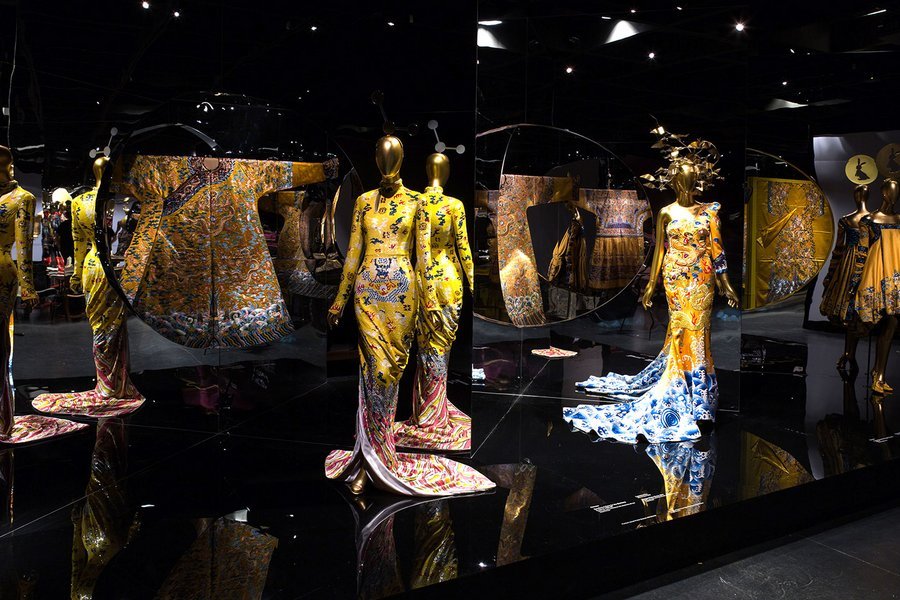When the Met’s exhibit on Chinese aesthetics and its influence on Western fashion was announced last year with the patronizing title “Chinese Whispers” it provoked a certain level of discomfort. Fashion is notorious for blindly and often offensively appropriating the traditions of dress and art from other cultures (see: the Céline plaid Chinatown bag, Chanel’s Native American headdress). One could only imagine its self-congratulatory tone as it paid tribute to what is essentially fashion’s version of General Tso’s chicken. Opening last week with a new title, “China: Through The Looking Glass,” the show turned out to be an outstanding effort, with a true embrace of the potential controversy.
“Through the Looking Glass” presents an exhaustive survey of Orientalism, what curator Andrew Bolton defines as a “Eurocentric view that essentializes Eastern peoples and cultures as a monolithic other,” and how it has manifested in the imaginations of fashion’s greatest from John Galliano to Tom Ford to Ralph Lauren. The exhibit’s new title, taken from the social satire by Lewis Carroll, addresses the cultural distortion of the orientalist eye. From blue porcelain gowns to sequined dragons, Bolton examines the various tropes and clichés of Chinese-ness. His scope and breadth is, frankly, awe inspiring.
Throughout the many rooms housing a mix of Chinese artifacts and designer couture, Bolton breaks down the Western gaze in every garment unlike any other costume exhibition to date. Juxtaposing a Galliano with the original Qianlong emperor’s robe that inspired it, its symbolism and embroidery techniques discussed in detail, the aesthetic traditions of China (so often reduced to a tourist’s notion of the exotic) are revealed to be full of depth and wonder. Bolton realigns fashion’s gross generalizations of China with their authentic beginnings. In this ever-global world the importance of the exhibit is clear: It’s a real education, a history reclaimed.
The poignancy of “Through The Looking Glass,” however, is undermined by Bolton’s exhibition text, which describes Orientalism as “a site of infinite and unbridled creativity… an appreciative cultural response by the West to its encounters with the East.” Like most ‘isms,” be it racism or sexism, Orientalism is damning to those who find themselves overgeneralized and oppressed by its blanketing view. It’s unlikely that the Chinese were “appreciative” during the Opium Wars of the 19th century, which saw the Chinese fending off the opium drug imports forced on them by the British, reducing their countrymen to drug-addled incompetents. The Chinese lost their fight for sovereignty and their punishment was to give Hong Kong to the British Empire. In 1977, when Yves Saint Laurent named his new fragrance after the drug and threw a party for it on a Chinese Junk ship, activists were enraged. Although Bolton does devote an entire room to Saint Laurent’s Opium debacle, his effusion for Orientalism mars an otherwise intelligent show.
Bolton insists that the cultural portrayal in “Through the Looking Glass” is not “one-sided mimicry but rather a layered series of enfolded exchanges.” This is a convenient perspective for an English curator working in an American museum. But while it doesn’t feel wholly honest it does help to highlight two crucial facts: for hundreds of years China was the leading tastemaker on the globe, and it’s now poised to be so again.
Since the days of Ancient Rome, China has steadily been influencing Western fashion. With its rich textile history (silk was invented in China) it has guided the taste of Europe’s wealthy elite as trading routes (think Marco Polo) increased the supply and demand for its rare and rich materials. Chinese textiles are a part of the country’s broader aesthetic history that was essentially cut off with the founding of the People’s Republic of China and the establishment of the Communist Party of China in 1949. Under Mao Zedong’s rule and communist directives, the cultural luxuries China was known for were deemphasized, and its fashion was essentially erased. For decades the reigning style of dress was the Mao suit, or Zhongshan. A tunic style jacket and matching pant, it is emblematic of the utilitarian styling of communism (Bolton does brilliantly point out the Mao suit’s counter-cultural significance in the West during the ’60s). It wasn’t until the 1990s that its popularity declined and the Chinese began to adopt Western fashion. Eventually, as the country’s communism loosened and the Chinese economy boomed, China grew to become the world’s top luxury market.
China is clearly on the verge of becoming an international fashion force with a distinct identity once more. Already Chinese and Taiwanese expats like Yang Li and Andrea Jiapei Li are capturing the attention of European and American audiences. Young Chinese students fill the world’s top fashion schools. The next generation of Chinese designers is emerging, quickly, and they are as talented as they are ambitious. And with China’s vast know-how of clothing production and a market large enough to support an army of designers, its global fashion dominance is all but assured.
“Through the Looking Glass” is a necessary exhibit that thoroughly addresses a long and all too pervasive history of cultural insensitivity that is becoming exponentially obsolete as a new global fashion culture develops. As we take in the Costume Institute’s exhibit of Chinese-inspired clothes we should all note (as Bolton did) that it is only a matter of time before the West finds itself on the other side of the mirror.
Credits
Text Jeremy Lewis
Image courtesy the Metropolitan Museum
